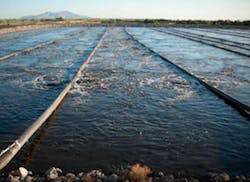Miner, Mo., population 980, is a quaint rural community located halfway between St. Louis and Memphis, Tenn. The 20-year-old Miner Wastewater Treatment Plant faced a number of technical issues in 2012. The town’s old three-cell 0.302-mgd aerated lagoon had high levels of suspended solids. Its ammonia and nitrogen concentrations were above their targets.
“There was quite a bit wrong with the plant,” said Chief Operator Marvin Hatton.
Miner needed to clean up its discharge to comply with Missouri Department of Natural Resources (DNR) and U.S. Environmental Protection Agency (EPA) regulations. The plant’s staff and City of Miner Engineer Norman Lambert decided it was time for a full-service upgrade. They called in Environmental Dynamics International (EDI) to assess the issues and develop a rehabilitation plan. Eventually, they decided a brand new plant should replace the old one.
“It would have been just as cheap to have a new [plant] put in [than] to have it cleaned out and put back in service,” Hatton said. “To be honest, it was just time to update.”
Downsizing to Upgrade
Lambert selected EDI to design and implement a new lagoon treatment plant for Miner. EDI proposed an Intermittently Decanted Extended Aeration Lagoon (IDEAL). The solution focused on eliminating solids, oxygen demand and ammonia in Miner’s wastewater. The IDEAL is able to provide full nitrification while removing a majority of total nitrogen through denitrification. The overall IDEAL process uses two ponds—the IDEAL for advanced treatment, followed by a partial mix basin with a settling zone for sludge storage and solids separation, thereby shrinking the size of Miner’s plant while improving its efficiency and effectiveness. The IDEAL aerates influent for two hours for BOD removal and nitrification before entering an anoxic settling and decant phase (one hour each), which provides denitrification, retains biomass and discharges clear water. Supernatant and stabilized waste sludge are partially mixed in the second pond to maintain a positive level of dissolved oxygen to digest solids and prevent ammonia rebound. A small portion of the secondary pond is a dedicated quiescent zone where solids that are not trapped in the partial mix zone settle, allowing clear water to flow out of the pond and to UV disinfection. Finally, the treated wastewater is discharged into the North Cut Ditch.
“It’s a pretty good little plant,” said Hatton. “Our numbers have been really good. I mean, really good.”
Major Improvements
When construction for the IDEAL process was fully completed in November 2012, EDI representatives spent a week training Hatton’s staff on the new equipment and processes. Since then, EDI has visited several times to check on the plant and ensure successful operation.
A joint effort between the City of Miner and EDI tracked the plant’s effectiveness during the record-cold winter of 2013/2014. Hatton and his staff gathered composite samples from the influent and effluent of the plant twice a week while monitoring the temperature in the IDEAL. Those samples were sent to Environmental Analysis South in Jackson, Mo., where the levels of total suspended solids, ammonia, BOD, nitrate, nitrite and total nitrogen were tested. Consistently, analysis of incoming and outgoing nutrient removal has been very positive. Ammonia levels, for example, have averaged 27 mg/L in wastewater entering the plant and drop to less than 0.05 mg/L by discharge; not one sample has come in above the method detection limit of the analysis. Similarly, BOD drops 230 mg/L to 4.5 mg/L, and suspended solids fall from 104 mg/L to 5.3 mg/L. Total nitrogen drops 66% from 32 mg/L to 11 mg/L.
A site visit from Missouri DNR officials in which samples were taken and tested also yielded enthusiastic feedback. Installing the IDEAL has brought Miner’s wastewater treatment plant well within DNR regulatory requirements.
Ongoing Partnership
To garner further maintenance support with its new water treatment system, Miner is entertaining a maintenance contract agreement with EDI. The City of Miner board of aldermen will vote on the proposal to provide the Miner Wastewater Treatment Plant additional maintenance assistance from EDI.
Should Miner and EDI develop a maintenance agreement to ensure the sustained success of the IDEAL solution, Hatton said he would welcome occasional EDI service visits.
“If I have any problem, I can call and they’ll do a little troubleshooting on the phone, and if that doesn’t take care of it, they’ll come down,” he said. “They’ve been really good with us.”
WEFTEC.14 attendees are encouraged to visit EDI's booth #7319 in New Orleans Sept. 27 to Oct. 1.



